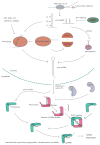MicroRNA regulation and role in stem cell maintenance, cardiac differentiation and hypertrophy
- PMID: 23642057
- PMCID: PMC3898432
- DOI: 10.2174/1566524011313050007
MicroRNA regulation and role in stem cell maintenance, cardiac differentiation and hypertrophy
Abstract
There are currently 1527 known microRNAs (miRNAs) in human, each of which may regulate hundreds or thousands of target genes. miRNA expression levels vary between cell types; for example, miR- 302 and miR-290 families are highly enriched in embryonic stem cells, while miR-1 is a muscle specific miRNA. miRNA biosynthesis and function are highly regulated and this regulation may be cell type specific. The processing enzymes and factors that recognize features in sequence and secondary structure of the miRNA play key roles in regulating the production of mature miRNA. Mature miRNA enriched in stem cells control stem cell self-renewal as well as their differentiation. Though specific miRNAs have been shown to control differentiation towards various lineages such as neural or skin cells, some of the most well characterized miRNAs have been found in promoting the formation of cardiac cells. In addition, miRNAs also play a critical role in cardiomyocyte hypertrophy, especially in a pathological context. Such miRNAs are predicted to be therapeutic targets for treating cardiovascular diseases. In this review we will discuss how miRNAs act to maintain the stem cell state and also explore the current knowledge of the mechanisms that regulate miRNAs. Furthermore, we will discuss the emerging roles of miRNAs using cardiomyocyte differentiation and maturation as a paradigm. Emphasis will also be given on some of the less ventured areas such as the role of miRNAs in the physiological maturation of cardiomyocytes. These potentially beneficial miRNAs are likely to improve cardiac function in both in vivo and in vitro settings and thus provide additional strategy to treat heart diseases and more importantly serve as a good model for understanding cardiomyocyte maturation in vitro.
Conflict of interest statement
The authors confirm that this article content has no conflict of interest.
Figures
Similar articles
-
Dynamic microRNA expression programs during cardiac differentiation of human embryonic stem cells: role for miR-499.Circ Cardiovasc Genet. 2010 Oct;3(5):426-35. doi: 10.1161/CIRCGENETICS.109.934281. Epub 2010 Aug 23. Circ Cardiovasc Genet. 2010. PMID: 20733065 Free PMC article.
-
Expression of microRNAs and their target mRNAs in human stem cell-derived cardiomyocyte clusters and in heart tissue.Physiol Genomics. 2011 May 1;43(10):581-94. doi: 10.1152/physiolgenomics.00074.2010. Epub 2010 Sep 14. Physiol Genomics. 2011. PMID: 20841501
-
MicroRNA profiling during cardiomyocyte-specific differentiation of murine embryonic stem cells based on two different miRNA array platforms.PLoS One. 2011;6(10):e25809. doi: 10.1371/journal.pone.0025809. Epub 2011 Oct 3. PLoS One. 2011. PMID: 21991358 Free PMC article.
-
Embryonic stem cell microRNAs: defining factors in induced pluripotent (iPS) and cancer (CSC) stem cells?Curr Stem Cell Res Ther. 2009 Sep;4(3):168-77. doi: 10.2174/157488809789057400. Curr Stem Cell Res Ther. 2009. PMID: 19492978 Review.
-
Cardiac-specific miRNA in cardiogenesis, heart function, and cardiac pathology (with focus on myocardial infarction).J Mol Cell Cardiol. 2016 May;94:107-121. doi: 10.1016/j.yjmcc.2016.03.015. Epub 2016 Apr 4. J Mol Cell Cardiol. 2016. PMID: 27056419 Review.
Cited by
-
MicroRNAs and Cardiac Regeneration.Circ Res. 2015 May 8;116(10):1700-11. doi: 10.1161/CIRCRESAHA.116.304377. Circ Res. 2015. PMID: 25953925 Free PMC article. Review.
-
Targeting miRNA for Therapy of Juvenile and Adult Diabetic Cardiomyopathy.Adv Exp Med Biol. 2018;1056:47-59. doi: 10.1007/978-3-319-74470-4_4. Adv Exp Med Biol. 2018. PMID: 29754174 Free PMC article.
-
NRF1-enhanced miR-4458 alleviates cardiac hypertrophy through releasing TTP-inhibited TFAM.In Vitro Cell Dev Biol Anim. 2020 Feb;56(2):120-128. doi: 10.1007/s11626-019-00419-3. Epub 2020 Jan 15. In Vitro Cell Dev Biol Anim. 2020. PMID: 31942725
-
Pathological Left Ventricular Hypertrophy and Stem Cells: Current Evidence and New Perspectives.Stem Cells Int. 2016;2016:5720758. doi: 10.1155/2016/5720758. Epub 2015 Dec 20. Stem Cells Int. 2016. PMID: 26798360 Free PMC article. Review.
-
MicroRNA Changes in Firefighters.J Occup Environ Med. 2018 May;60(5):469-474. doi: 10.1097/JOM.0000000000001307. J Occup Environ Med. 2018. PMID: 29465512 Free PMC article.
References
Publication types
MeSH terms
Substances
Grants and funding
LinkOut - more resources
Full Text Sources
Other Literature Sources

